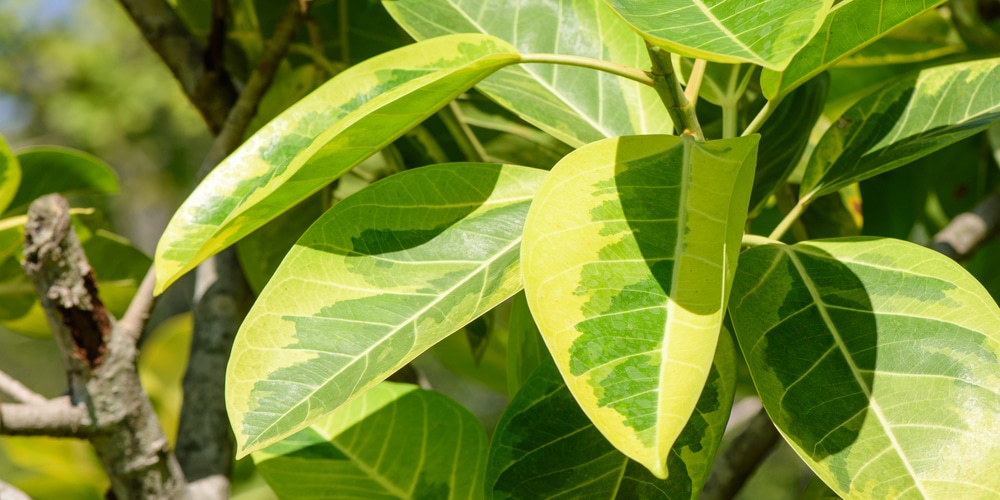The Ficus Altissima plant is a lovely houseplant that’s related to the fiddle leaf fig. It will bloom and fruit in the wild but is unlikely to do so when kept indoors. These plants are also commonly called the Asian council tree as they are native to southeast Asia and the Pacific Islands.
Ficus Altissima is a great air purifier and is very popular as they are easy to care for. Let’s look at how to grow and care for a Ficus Altissima plant.
What is a Ficus Altissima plants?
Ficus Altissima is a stunning plant with variegated leaves that can be dark to light green, yellow, rusty colored, and lime. The foliage is unique, has eye-catching markings, and is very similar to the leaves of a rubber tree, which is of the same family.
Ficus Altissima is relatively fast-growing and can get very tall in the right conditions. In its native lands, it can grow up to 40 feet tall and 30 feet wide. The trees bloom in the spring and produce figs. If you live in USDA zones 9 to 12, you can grow a Ficus Altissima outdoors. When grown indoors, these plants will remain a lot smaller but can still reach 6 or 8 feet tall.
How to Care for a Ficus Altissima Plant
Ficus altissima plants are relatively forgiving and can thrive, even if conditions aren’t perfect. They are easy to care for but are sensitive to changes in conditions. Stress can affect the plant and cause it to drop its leaves, so keeping conditions stable is a must. In time a plant that’s dropped its leaves will bounce back. Here are some tips to help you grow a thriving Ficus Altissima plant:
Sunlight
Ficus Altissima prefers to grow in bright indirect sunlight. When placed in full sun, the leaves are likely to become sunburnt, while too much shade will cause the foliage to become dull. If you live in a hot, sunny area, you may like to grow your plant under shade cloth to prevent burning.
Watering Requirements
Ficus altissima can be left to dry out slightly between watering. You can test the soil with your finger and check that the first two inches of topsoil are dry before watering. The amount of water your plant needs will depend on the humidity and temperature of your home. Most people find that their plant needs to be watered once a week during the growing season. You can reduce watering slightly in the fall and winter.
Be careful not to overwater your plant as Ficus Altissima are sensitive and can die if the soil becomes waterlogged. Overwatering will cause your plant’s leaves to turn yellow and will lead to root rot.
Underwatering can also affect the plant and will cause the edges of foliage to turn crisp and yellow.
Soil and Repotting
Ficus Altissima grows well in a good quality houseplant potting mix. You can also add some perlite to the soil to improve drainage and reduce the chances of root rot. It’s also beneficial to add peat moss and sand to the soil.
When repotting your plant, you can add a layer of gravel or pebbles to the bottom of your plant’s pot. This will allow any excess water to drain away and stop the soil from becoming waterlogged.
Temperature
Ficus altissima grows best when the temperature is warm. These plants thrive in the average home and should be kept at between 60 and 68 F. They aren’t very resistant to cold and should be kept away from drafts and air conditioning.
Ficus altissima plants can be grown outside in warmer regions, as long as the winters are mild. If you live in an area with colder winters, you can move your plant into your home or a greenhouse in the fall. Be careful not to expose your plant to intense temperature changes, or it may become shocked and lose its leaves. Change the temperature gradually to avoid this issue.
Humidity
Ficus altissima prefers to grow in an environment that’s humid and can be grouped with another tropical plant to create a microclimate that’s high in humidity.
You may need to mist your plant if you live in a drier climate. Be careful not to soak the leaves as this could cause them to rot. Alternatively, you may like to invest in a humidifier if you own lots of tropical plants.
Fertilizer
Ficus Altissima plants will grow quicker and look healthier if they are fertilized regularly. You can use either a liquid or slow-release fertilizer at half strength about three times annually.
Ficus Altissima plants have sensitive roots that can be damaged by too much chemical fertilizer. It’s best to use an organic product to avoid chemical build-up, which could burn the plant’s roots.
Pruning
As Ficus Altissima ia a large plant, you may like to prune your plant to keep it smaller and more manageable. Trimming off dead or damaged leaves will make your plant look tidy and help encourage new growth.
It’s best to prune Ficus Altissima plants either in the late winter or the early spring. Ensure you use sterilized tools and trim stems above the leaf nodes.
When you prune a Ficus Altissima, it’s best to wear gloves as a white, milky substance will appear. This sap can cause skin irritation as it’s mildly toxic. Wash your hands immediately if it comes into contact with your skin and seeks medical attention if necessary.
Conclusion
Ficus Altissimas are very easy plants to care for and are relatively fast-growing. These plants don’t require expert care and are pretty forgiving if the conditions aren’t perfect. Place your plant in bright, indirect sunlight and water consistently.
Be careful not to shock your plant by changing the temperature of lighting abruptly. These plants are sensitive and will drop their foliage due to stress. A plant that’s dropped its leaves will look sad but is most likely to recover in time.
Related Ficus:
